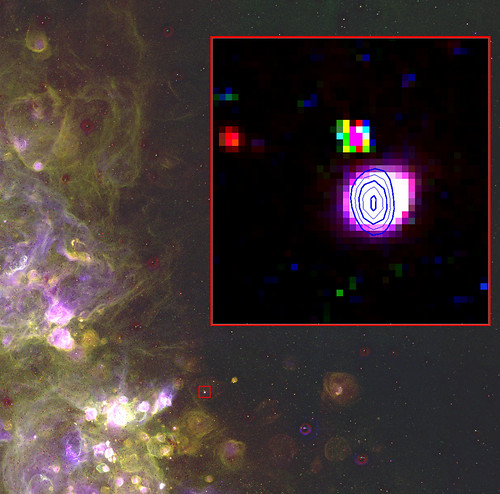Death of a Star

An optical image from the 0.6-m University of Michigan/CTIO Curtis Schmidt telescope of the brightest Radio Planetary Nebula in the Small Magellanic Cloud, JD 04. The inset box shows a portion of this image overlaid with radio contours from the Australia Telescope Compact Array. The planetary nebula is a glowing record of the final death throes of the star. (Optical images are courtesy of the Magellanic Cloud Emission Line Survey (MCELS) team).
The current Monthly Notices of the Royal Astronomical Society is reporting on super planetary nebulae, with University of Western Sydney Associate Professor Miroslav Filipovic going so far as to call them sexy in an interview with ABC:
Filipovic believes planetary nebula images are the most impressive objects in the galaxy.
"When you look at the Hubble pictures, they are the sexiest pictures you can find," he says.
According to Filipovic, it’s important to understand how super planetary nebulae form, particularly as they represent the fate of our Sun.
"This is something that will happen to us in about five billion years from now," he says.
Get a load of the abstract:
We report the extragalactic radio-continuum detection of 15 planetary nebulae (PNe) in the Magellanic Clouds (MCs) from recent Australia Telescope Compact Array+Parkes mosaic surveys. These detections were supplemented by new and high-resolution radio, optical and infrared observations which helped to resolve the true nature of the objects. Four of the PNe are located in the Small Magellanic Cloud (SMC) and 11 are located in the Large Magellanic Cloud (LMC). Based on Galactic PNe the expected radio flux densities at the distance of the LMC/SMC are up to ∼2.5 and ∼2.0 mJy at 1.4 GHz, respectively. We find that one of our new radio PNe in the SMC has a flux density of 5.1 mJy at 1.4 GHz, several times higher than expected. We suggest that the most luminous radio PN in the SMC (N S68) may represent the upper limit to radio-peak luminosity because it is approximately three times more luminous than NGC 7027, the most luminous known Galactic PN. We note that the optical diameters of these 15 Magellanic Clouds (MCs) PNe vary from very small (∼0.08 pc or 0.32 arcsec; SMP L47) to very large (∼1 pc or 4 arcsec; SMP L83). Their flux densities peak at different frequencies, suggesting that they may be in different stages of evolution. We briefly discuss mechanisms that may explain their unusually high radio-continuum flux densities. We argue that these detections may help solve the ‘missing mass problem’ in PNe whose central stars were originally 1–8 M⊙ . We explore the possible link between ionized haloes ejected by the central stars in their late evolution and extended radio emission. Because of their higher than expected flux densities, we tentatively call this PNe (sub)sample –’Super PNe’.
Sexy indeed.